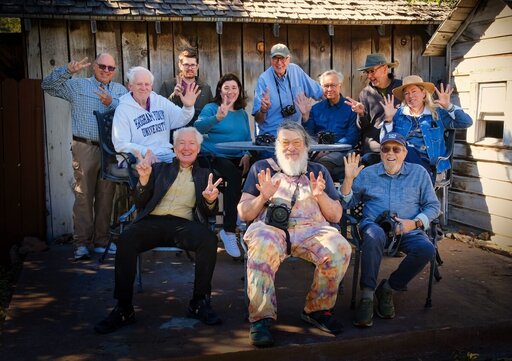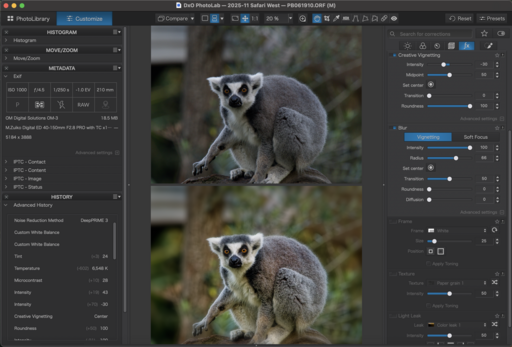This is The Digital Story Podcast 1,031, Dec. 23, 2025. Today's theme is, "More Realistic Film Simulations with a Dash of Grain." I'm Derrick Story.
Film simulations by Fuji, Nikon, and OM System are great for color and tones, but there's a missing ingredient when compared to actual analog shots: grain! This week we're going to explore the virtues of a few dashes of grain and learn how to apply it for more realistic film simulations. All of that, and more, on today's TDS Photography Podcast. I hope you enjoy the show.
Tune-In Via Your Favorite Podcast App!
Apple Podcasts -- Spotify Podcasts -- Stitcher
Podbean Podcasts -- Podbay FM -- Tune In
More Realistic Film Simulations with a Dash of Grain
Author's Note - I've published an article on Live View that includes lots of photo examples to accompany the text. You can read it for free here.
This all started with Firmware Update 3.0 for my Nikon Zf. There were all sorts of great new features including on they called Film Grain Options.
I had to check this out. It features six intensity levels and three grain sizes. Generally speaking, I select intensity level 2 or 3 and small for the size. Combined with a film simulation setting, such as Tri-X or Kodacolor, the results are much closer to real film than anything I had previously rendered from a digital camera. It was the missing ingredient!
The new Film Grain Options is located in the Camera Menu about two-thirds the way down. Remember, you have to upgrade your firmware to V3.0 for it to appear.
I recommend shooting RAW+Jpeg when working with grain and simulations. The settings will be applied to the Jpeg, and the RAW remains a pure capture without the effects. Nail the exposure, and you can use the Jpegs right out of the camera. The RAWs are there if you need them.
For extra fun, I recommend using a vintage Nikon lens with the FTZ II adapter to further enhance the analog look. If you use an AI-S optic, such as the Nikkor 50mm f/1.8 AI-S with the FTZ II, you'll still retain a lot of camera functionality, such as Aperture Priority, but get closer to that classic Nikon look. Don't forget to add the lens to the Non-CPU Lens Data option in the menu. By doing so, its information will be listed in the EXIF metadata of your shots.
The OM System OM-3 Film Grain Option
The Nikon Zf isn't the only camera that provides this feature. I continued my research and discovered that the OM System OM-3 has its own grain implementation. I love shooting B&W with this camera via the MONO setting on the front creative control dial.
What I discovered was that after I choose the MONO 1 setting, I can fine tune its rendering. The options include highlights/shadows, shading effect, sharpness, and yes, Film Grain Effect.
OM System provides four grain choices: Off, Low, Medium, and High. I started with Medium for MONO 1, and loved the results. Why didn't I figure this out earlier?
FujiFilm X100V Offers Film Grain Too
Surely Fuji, with all of its great film simulations, wouldn't pass on this opportunity. And even though their implementation isn't as flexible as Nikon's, it's available.
On my X100V, Grain Effect is listed in the IQ menu with two parameters: Roughness and Size. Each parameter has options. For Roughness, there's Strong, Weak, and Off. For Size, we can choose between Large and Small.
I combined Strong with Large and selected the Acros film simulation. And just like my experience with the Nikon Zf and the OM-3, adding film grain to the Acros simulation enhanced its analog-like rendering. This option was also available on the GFX100S medium format camera, so I'm guessing that it's there for all Fujifilms.
Comparing Film Grain Renderings to RAW Files
As much as I like creating Jpegs that I can use right out of the camera, I still capture RAWs as well. There are scenarios when I don't want the effects and would rather start from scratch with a RAW file.
Plus, the RAWs are also great for comparison purposes. They're like the "control files" in a whacky creative experiment. My query: Were the grainy film-simulated images better than the smooth, saturated digital files? As you may have guessed, it depends on the subject and the story being told.
I also like that I can go crazy with the Picture Controls on the Zf (where the film simulations are located), add grain, and not worry about overdoing it because the RAW version is always there if I need it. For me, this encourages experimentation and creativity.
You Can Do It in Post Too
If your camera doesn't offer built-in grain control, or you want more fine-tuning capability than what it offers, you can add this effect in post-production. Most apps include this adjustment.
In Lightroom, for example, you can change the amount, size, and roughness of grain with sliders, so it seems more controllable than it is in-camera, which bakes it in. The colors remain true, but the grain can vary.
Final Thoughts
All of this craziness began with a firmware update for the Nikon Zf. A shoutout to them for continually refining an already great camera.
And I've also learned that film grain is artistically different than digital noise. As I examine actually film photos and look at the gain patterns, I find them pleasing. They add sharpness and tooth to the pictures. Nikon further enhances this effect by randomizing the grain in a similar fashion as actual film. Theoretically, no two digital pictures are alike.
But this is also a revelation for my OM-3 and X100V. Again, as much as I previously enjoyed shooting in MONO with the OM-3 or Astia with the X100V, they never quite looked as analog as I wanted. Now those images come much closer.
I love shooting with real film. But it isn't always convenient. Now I feel like I have more control over the type of images I want to create with my digital cameras.
It all started with a firmware update and the question, "Why the heck did they add Film Grain Options to my Nikon Zf?" Now I know why.
This Week in the News
Why are Olympus cameras so overlooked? It's the best image quality possible for the size as featured on AmateurPhotographer.com
Ricoh's latest, haziest version of the GR IV is nearly here as featured on DPReview.com
This Street photographer used a 7-year-old Fujifilm camera to shoot a Coca-Cola campaign as featured on DigitalCameraWorld.com
10 Movies About Photography Worth Watching as featured on FStoppers.com
Virtual Camera Club News
Workshops!
The 2026 TDS Photography Workshop Season. We are featuring webinars, online workshops, and in-person events focused on creating impactful images in the company of those who love photography as much as you. Our workshops are like no others, and we think you will throughly enjoy the camaraderie and the tips and techniques.
This week I want to feature the Mobile Photography with the iPhone, iPad, and Mirrorless Camera. The iPhone, combined with a compact camera, is a powerful tandem for on-the-go photography. In this online workshop, we will explore how to pull together these devices to build a robust and enjoyable workflow. We start on Wednesday, Jan. 28.
Stop by The Nimble Photographer Workshop Page and reserve your spot today.
Inner Circle Bold. Sign up for the Annual Membership that's only $75.60 a year, you will receive all of the regular Inner Circle benefits, plus a coupon for your choice of a 2026 Online workshop hosted by me.
Great Photography Articles on Live View - If you check out our publication and appreciate what you see, be sure to follow us and clap for those authors. You can find us at medium.com/live-view.
If you're interested in writing for Live View, drop me a line at dstory@gmail.com.
The Nimble Photographer Newsletter is now publishing every Thursday. Readers will enjoy a variety of content spanning from short photo essays, to commentary on weekly events, to reviews of the latest and coolest photo gear.
Inner Circle Members: A big thanks to those who support our podcast and our efforts! We are having a blast at our new Inner Circle hangout, the private group I've set up at DerrickStoryOnline. We'd love it if you join us. You can become an Inner Circle Member by signing up at our Patreon site. You will automatically be added to the new hangout.
The New Donation Kit for Carefree Shipping of Found Film Cameras - If you've discovered a film camera that's no longer being used, our new Donation Kit makes it easy to pack and ship. Just visit the Contact Form on thenimblephotographer.com, click the box next to Donating a Film Camera, and let me know what you have. In your note, be sure to include your shipping address.
Affiliate Links - The links to some products in this podcast contain an affiliate code that credits The Digital Story for any purchases made from B&H Photo and Amazon via that click-through. Depending on the purchase, we may receive some financial compensation.
Red River Paper - And finally, be sure to visit our friends at Red River Paper for all of your inkjet supply needs.
See you next week!
You can share your thoughts at the TDS Facebook page, where I'll post this story for discussion.





































